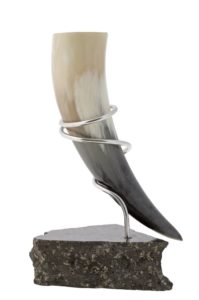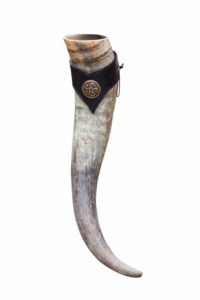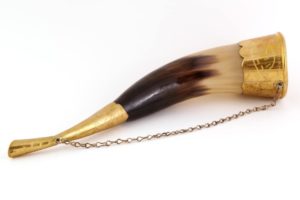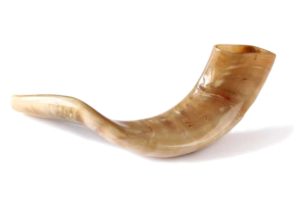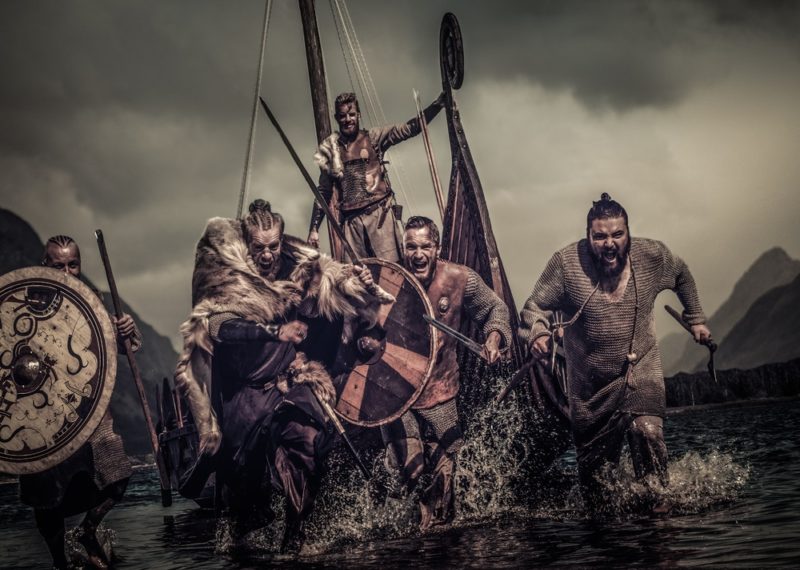According to archaeologists, Viking drinking horns have been around for more than 2,000 years. They are historical representations of Viking culture and the people who once inhabited Scandinavia and the surrounding areas. These drinking vessels were crucial for serving wine, beer, ale, and mead, the Vikings’ preferred beverage, in addition to being a decorative piece.
Several cultures have adopted these Viking drinking horns because of their functionality and accessibility. They have been utilized for a variety of things, from recreational drinking to religious rituals.
If you are an avid Viking fan, you’ve probably seen one of these relics, whether infamous Viking films or on online stores, where ethically sourced, hand-polished drinking horns can be obtained. The tradition of drinking from a horn can be traced back to the Vikings, who, of course, established them.
What Exactly Is a Drinking Horn?
Traditionally, the Viking drinking horn, also called the mead horn by the Vikings, was constructed from bovid horns. Several drinking vessels were made by other cultures from other materials such as glass, ceramic, or metals to imitate the drinking horn.
Historically, the Vikings used cow horns in their original shape to make their drinking horns, which meant that these vessels had an open rim that people would hold to the mouth to sip their drink. It also had a narrow end that closed in a point. Because these horns closed in this way, they were ideal for holding liquids like warm water, ale, and beer.
However, their pointed design meant that there was no flat base, so if you were given a drink at a Viking feast, you had no other choice but to finish it because you could not set it down. Although a few horns had a curved, almost spiral shape, most had a C-shape. Vikings sometimes decorated their drinking horns with precious metals, which symbolized their status.
The History of the Viking Drinking Horn
The Viking drinking horn was noted for its historical significance. The Norse were used to drinking alcoholic beverages, and Apple Cinders may have been one of their favorite drinks.
A Lack of Suitable Materials
These individuals required a suitable object to carry their drinks at a time when materials such as glass and plastics that offered a leak-proof quality were unavailable. They figured out a way to create holes in cow horns to create an innovative invention that would ultimately outlive their creators and go down in the history books.
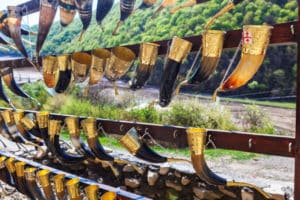
The tradition of using drinking horns has become a symbolic part of many cultures around the world and is thought to have started with the Vikings.
The Norse Used Every Part of the Animal
In the Viking age, the world was a harsh place to live in, and people had to do all they could to survive. When it came to food, the Vikings did everything they possibly could to make sure they had enough to eat. Throughout history, certain civilizations have believed in using every part of the animal they killed for nourishment.
The people did not know when they would get their next meal, and supplies were obtained in any way possible. Meat, in particular, was hard to come by. Therefore, people tried their best to make use of every part of the animal.
This was also done out of respect for the creature and, by extension, for nature as a whole. You may not realize it, but this is a long-standing custom that, like alcohol, extends back much further than anyone can remember.
Use in Native America
The native American drinking horn took on a somewhat unique configuration in some locations, evolving from cutlery rather than the complete horn, resulting in drinking ladles rather than drinking vessels. These horns were comparable to those used by various tribes around the world.
Wounded Head, a Nez Perce fighter, had a leather cord linked to his drinking horn so that he could drop it into a river or creek to get water while he was atop his horse. The dots engraved at the tip represent the lives of the tribesmen whose lives were lost in the Big Hole Battle in Montana in 1877.
When and How Were Drinking Horns Used in Norse Culture?
While drinking horns may have been used for casual drinking, they were often an essential component of Viking feasts and were often handled by women as they served a drink to their family members or guests. Here are a few ways that drinking horns were used in the days of the Vikings
Viking Feasts
Every Viking feast required the use of a drinking horn. Many horns were expertly crafted and adorned with a gold or silver border or end. Horns regularly feature in the sagas and are widely portrayed in their artistry.
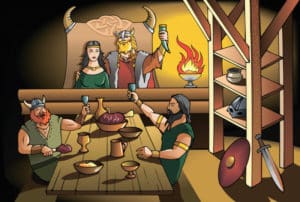
A Valkyrie is often depicted delivering one of these drinking vessels to a brave Viking warrior or perhaps Odin himself. These drinking horns may have served an important function during large events and ceremonial rites.
Drinking horns were generally used for drinking alcoholic beverages such as mead and beer. Therefore, your Viking host would not let you put your drink down until you’d completed it. The ultimate goal with a drinking horn was to empty it.
Passed down from Generation to Generation
Because many drinking horns were hand-crafted and sometimes included exquisite elements fashioned from precious metals, they were often passed down from one generation to the next.
Cattle Was Scarce
Another possible reason for this is that animals were hard to come by, so parents passed their drinking horns down to their children so they would not have to search for drinking vessels at a time when materials and food were scarce.
They Grew in Value Through the Generations
As these horns were passed down through the generations, each generation would add their own design or ornaments to these vessels, which added to their worth over time.
What We Learn from Viking Burial Sites and Other Historical Artifacts
When you think about Vikings and drinking horns, you might imagine a group of huge, burly seamen gathered around a long table, celebrating their recent capture. While this may be accurate, the Viking drinking horn was much more closely associated with women than we may already know.

The Valkyries
Valkyries (female spirits or deities that the Norse believed decided which warriors would live or die in battle) were frequently pictured in Viking mythology as handing drinking horns to deceased soldiers to usher them into the dead hall the Norse referred to as the Valhalla.
Horns Were Not Buried with Viking Warriors
Historically, Viking drinking horns were not a part of the ceremonial burial of Viking warriors. Almost all of the drinking horns recovered in Norse burials were found in the burial sites of women and not men. This may have been because women were typically the bearers of mead, so they were the ones who carried the drinking horns.
Release Your Inner Viking: Viking Drinking Horns Today
The tradition of drinking from a Viking drinking horn has not been lost, and several manufacturers dedicate their time and effort to producing authentic Viking drinking horns. Norse culture has been widely documented, which gives people of today a good idea of how the Vikings lived, and many enjoy the use of drinking horns in memory of the Norse.

Today, you can simply select the drinking vessel you prefer, close cart, and make payment via Venmo Visa or Apple Pay Diners Club. Here are a few ways that people enjoy the tradition of washing down their drink from a horn.
The Coffee Horn or Mug
Traditionally, drinking horns were used for drinking alcoholic beverages such as beer, wine, ale, and mead. However, they are now being used for hot beverages like tea and coffee. If you have a family member who absolutely loves Vikings and prefers hot beverages, a coffee horn will make the ideal Christmas present or birthday gift.
How These Horns Are Made
These horns are typically made in the form of coffee mugs and are super-heated to form the smooth curving handle, which is essentially an extension of the real horn that has been meticulously bent back it has been heated.
An Authentic Horn for Beer and Mead
Release your inner Viking by obtaining a drinking horn designed for beer, mead, wine, ale, and other such drinks. A real horn typically maintains its original shape.
Modern Variations
These hand-cut modern recreations often include a custom stand that lets you set your drink down when you need to. Stands are usually made from wood or metal.

Some modern horns include a strap that lets you hang it around your neck instead of setting it down on a stand. While Vikings did not typically use a stand or strap for their horns (because they believed that they had to be emptied once filled), these additions serve a great functional purpose.
The Perfect Gift
Today, a drinking horn makes the perfect gift. It is a symbol of enjoyment and offers unique insight into the life of a Viking. You can shop from several online stores, including Amazon, to find the best quality horn to present as a gift.
Who wouldn’t want a beautiful Viking drinking horn?
Symbolism and Use in African Civilizations
Throughout time, drinking horns were an integral element of African civilizations’ rituals and ceremonies. Elites of Cameroon’s Grassfield Monarchies, for example, sip wine from sculpted buffalo horns, which have now been replicated in wooden counterparts. Because of its cunning and lethal nature, the buffalo is regarded as a regal icon by the people who hunt them.
Frequently Asked Questions
We answer some of your most pressing questions about the drinking horn in the section below.
1. Were Drinking Horns Used by Christians in Ancient Times?
Drinking horns made the transition from heathen to Christian civilization in Medieval times, gaining favor amongst clergy and noble families in the 1300s. Christians embraced the tradition of using a drinking horn with such zeal that a horn is frequently displayed among the presents given to the Baby Jesus at His birth.
They Used to be Very Ceremonial
Drinking horns were primarily ceremonial in the 1400s. They had profound symbolism and were frequently given as gifts at courts, but they were no longer used for anything other than ornaments and symbols of high status.
2. How Are Drinking Horns Made?
Extract the Marrow
The inner core of an ox, buffalo, or cow horn must be extracted before it can be used as a drinking horn. This is accomplished by immersing the horn in warm water or boiling the entire horn, then scooping out the mushy bone marrow.
Shaping these Horns
After that, the horn is re-softened using heat and molded into the appropriate shape. In the case of several modern horns, a tongue or tail shape is created by heating the horn and pushing the end back to form a handle. Traditionally, the bovine horn was left in its original shape and did not require heat treatment.
Finishing Touches
Modern horns are then cleaned and polished to produce a high luster after being treated with a specially developed food-safe lacquer. Lastly, it is embellished with metal accents or etched with engravings depending on the style.
3. Who Was the First to Use a Drinking Horn?
The truth is that nobody knows who was the first nation in history to include a drinking horn as part of their culture. However, we have learned that people worldwide were drinking from a horn approximately 2,600 years ago.
The Greeks and Scythians
Greek pottery dating back to 450 BCE depicts the deity, Dionysus, sipping from a horn.
These drinking horns were also popular among the Scythians. In roughly 900 BCE, the Scythians were a wandering people who resided and hunted in the region we now know as Siberia. The civilization they constructed around the drinking horn was quite elaborate.
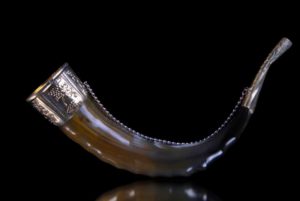
While the Greeks drank from horns made of bones and occasionally wood, the Scythians drank from horns made completely of valuable materials such as silver and gold. These ornate horns were discovered buried with their soldiers, and it is thought that being buried with a horn denoted their status.
Romans
The Romans pushed this practice to the next level by creating magnificent glass horns to be used for festivities. Drinking from a horn was considered a sign of prosperity and authority. Because of the Roman Empire’s prominence, drinking horn tradition extended to other European countries, including the Iron Age Celts.
Iron Age Celts
The Iron Age Celts were known for their revelry. They, much like the Romans, saw these horns as an emblem of wealth. Gold and other such materials were used in some variations, which were embellished with intricate carvings and even handles.
These accessories meant were more than just feastware to the Celts, and horns with a metal rim have been unearthed in burial grounds as a token of respect for the dead.
Final Thoughts
The Viking drink horn was a symbol of the Viking culture and was typically used for holding alcoholic beverages such as beer and mead. Today, it is enjoyed as a classic reminder of how the Viking nation lived.
Purchase a Viking Drinking Horn Today!
If you want to enjoy your drinks the way the Vikings did, you can purchase one of these accessories from several shops or online stores around the world to share a drink with friends the way the Vikings did. A drinking horn also makes a great gift, and today comes with functional additions like a stand or carry band for added convenience.

